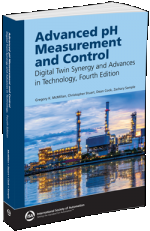Tab Article
The extraordinary sensitivity and rangeability of pH used for measuring and controlling hydrogen concentration introduce many difficulties in addressing the exceptional consequential nonlinearity in the control loop and precision requirements of the control valve. This, combined with the critical role of pH for the health of cells in biological processes, clean water, and the production of foods, pharmaceuticals, and many chemicals, translates into the best pH control system being particularly critical and challenging.
This book provides knowledge of key principles and advances in electrode technology and diagnostics; a largely unrealized, simple method of computing titration curves that match laboratory curves; and the selection and implementation of the best control valves and control strategies. Despite the many challenges, the results can be a significant reduction in equipment cost and, more importantly, a remarkable improvement in system reliability and performance.
The role of the digital twin and a first principle charge balance in design, testing, and training to provide the innovation, implementation, operability, reliability, and maintenance needed is detailed. Finally, the appendices discuss the essential fundamentals of first principles and provide guidance on using new PID features that enable greater achievements in minimizing project costs and maximizing process efficiency, capacity, and safety.


